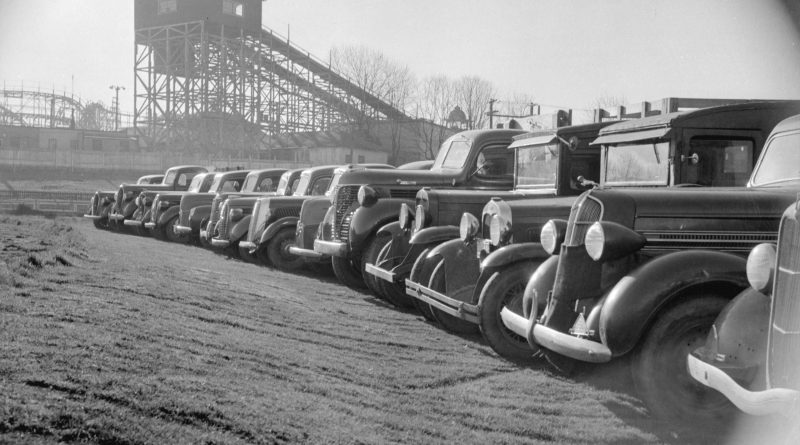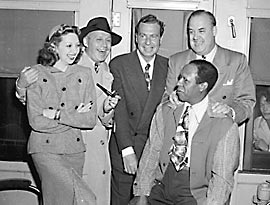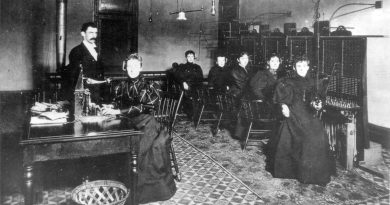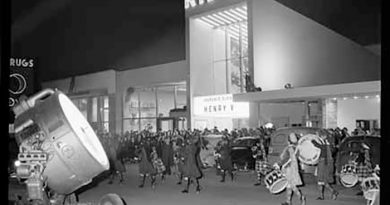1942
Above: Vehicles, confiscated from Japanese nationals, at Hastings Park
[Image: Vancouver City Archives AM1184-S3-: CVA 1184-88]
*****************************************
You’ll note that these years include events listed under “Also in . . .” These are events for which we don’t have a specific date. If YOU know the specific date of an event shown there, please notify us . . . and cite the source! Many thanks!
*****************************************
January 7 Joe Quoy, jockey, died in New Westminster, aged about 54. He was born about 1867 in New Westminster, writes Constance Brissenden, to parents who had come from California following the gold rush. His father ran a store in New Westminster and owned several horses. The first races in New Westminster were held on Columbia Street, then unpaved. Joe was 12 years old and 90 pounds when he first raced. He rode at tracks in B.C., including Langley and Nanaimo, and in Seattle, Portland and Walla Walla. After putting on weight, he turned to sulky riding.
January 8 Physicist Stephen Hawking was born.
January 10 The Vancouver Fire Department’s ‘inhalator’ crew, the Rescue and Safety Branch, was put in service. Over the years, these men saved the lives of many.
January 13 His first speech in the legislature was made by W.A.C. Bennett.
January 14 Ottawa announced that all Japanese were to be removed from the west coast to government camps. Fearing Canada might be next after Pearl Harbor, and that collaborators might be harboured aboard Japanese boats in Steveston, the Canadian government invoked the War Measures Act.
January 18 Newspaper publisher Don Babick was born.
January 22 The federal government announced plans for an RCAF storage depot on the Kitsilano Indian Reserve west of Burrard Bridge.
February 26 British Columbia’s Japanese were ordered interned.
March 3 The City of Vancouver began the acquisition of land from Stanley Park to Burrard Street.
March 26 Hastings Park in Vancouver became an internment camp for Japanese-Canadian citizens.
April 1 Japanese-Canadians begin to be moved from the west coast to internment camps in the interior and points east. The government “took into custody” 1,337 of their fishboats, as well as houses and other property. The owners received little or no compensation. Not only the entire fishing fleet, but also other businesses, radios, cameras and cars were confiscated. Newspapers were suppressed and language schools were closed. The owners received little or no compensation. Steveston was particularly hard hit.
And a light in a Stanley Park monument built to honor Japanese-Canadian soldiers who had fought bravely and with high casualties for Canada in World War I was turned off.
May 1 Canadian Pacific Airlines was born with the amalgamation of 10 northern bush plane companies by the CPR. Their first planes were Canadair C4 Argonauts and then DC6s. The new company focused at first on servicing routes within the province from the airport on Richmond’s Sea Island, would expand into the far northern reaches of the other provinces and territories.
May 20 The Crosline, a vessel launched in Seattle June 22, 1925 for the Crosby Direct Line Ferries Company, arrived from Seattle to join Burrard Inlet ferries. She could carry 300 passengers and 65 cars, was purchased because of the need for more ferries to take shipyard workers to the north shore. In 1947, after the war, the Crosline was sold to the ferry system of the Washington State Department of Highways who rebuilt her. (Her final years were weirdly interesting, according to this excellent website. “Her last trip was the 9:55 p.m. departure on Labor Day of 1967. The ferry system sold her on December 19th of the same year. She was first used as a warehouse on Lake Union. Sold again in 1975, she was moved to Coos Bay, Oregon to be used as a restaurant. The venture fell through, and instead her superstructure was removed to become a shore-based warehouse. Her hull was eventually disassembled, the remaining timbers and planks of the Crosline became part of a fishing boat and a dock.”)
Also May 20 William Marr Crawford, master mariner, died in Vancouver, aged about 59. He was born in 1883 in Limekilns, Fife, Scotland, came to Canada in 1911. He joined Empire Stevedoring, B.C.’s largest waterfront employer, as manager. In 1923 he was named president and managing director. In 1930 he launched the Fyfer, “the finest private yacht on the Pacific,” and in 1941 donated her to the Canadian Navy for war use. In the First World War, Captain Crawford had served as marine master to the ministry of shipping without pay, and served in the same role in a civilian capacity in World War Two.
June 21 Broadcaster and Mount Pleasant organizer Dave Adair was born.
June 30 DJ, VJ, actor and interviewer Terry David Mulligan was born.
July 1 Alexander Maitland Stephen, writer and poet, died in Vancouver, aged about 60. He was born in 1882 in Hanover, Ontario. In his early years, Stephen tried ranching and mining, as well as rural teaching. He was wounded in the First World War. Back in Vancouver, he opened an engineering company. He was a well-known progressive social activist, a nationally known critic and the author of two novels, plays, romances and poetry. His 1934 poem Vancouver was widely anthologized; a portion of it was reproduced on the inside covers of the 1997 The Greater Vancouver Book. (See 1934.)
July 5 Industrialist Edgar Kaiser was born.
July 28 The Nine O’Clock Gun was silenced to save gunpowder.
August 9 A.E. McRae’s Hycroft mansion in Shaughnessy, built at a cost of $109,000 in 1909, was sold by the McRaes to a grateful federal government for $1. (There were rising costs and the Second World War made hiring of staff difficult.) Shaughnessy Military Hospital was full to bursting with convalescent soldiers and Hycroft was put to immediate use to handle the overflow.
It would serve as an auxiliary to the hospital for 18 years. Then a new wing was added to Shaughnessy and Hycroft was emptied. It sat empty for two years, then the University Women’s Club bought it, and they’ve occupied it ever since. Incidentally, women were not allowed to hold mortgages in their own right at the time and so the club was required to pay in full. It took them a year to raise the money.
In its original configuration Hycroft was a 30-room home (11 of them bedrooms), with a coach house, stables, a swimming pool, an Italian garden and more, all on 5.2 acres.
August 19 Vancouver’s Colonel Cecil Merritt became the first Canadian in World War II to win the Victoria Cross. His citation reads, in part, “For matchless gallantry and inspiring leadership whilst commanding his battalion during the Dieppe raid on the 19th August, 1942. From the point of landing, his unit’s advance had to be made across a bridge in Pourville which was swept by very heavy machine-gun, mortar and artillery fire: the first parties were mostly destroyed and the bridge thickly covered by their bodies. A daring lead was required; waving his helmet, Lieutenant Colonel Merritt rushed forward shouting, ‘Come on over! There’s nothing to worry about here.’” For more, see this site.
August 24 The Wartime Prices and Trade Board began the issue of ration books covering purchase of sugar, coffee and tea.
September 13 Some World War Two excitement was engendered today. Writing in The Vancouver Book (1976), Peter Moogk relates: “It was a hazy Sunday when a fish-packer sailed in across the ‘examination line’ from Point Atkinson to Point Grey, oblivious to the wartime crisis. As the boat chugged on towards the First Narrows, the gunners at the fort received a message to fire a ‘stopping round’ ahead of the boat to compel the master to come to a stop and to identify himself. It was customary on such occasions to fire a non-explosive, solid shell that would kick up a large splash in front of the offending vessel . . . When one of the 12-pounder guns of the fort fired the ‘stopping round,’ the shell hit a wave and started to ricochet across the water at an oblique angle. Beyond the fish-packer in English Bay was the Fort Rae, a 9,600 ton freighter that had been launched the month before and was still on its sea trials. The skipping round hit the freighter above the waterline. As the shell passed through the number 3 hold it turned sideways and punched out a hole below the waterline on the other side. At first this was not noticed. The ship was evidently on its way back to the Burrard Drydocks when the captain received word of flooding in the hold. He beached the freighter on the north shore, just inside the First Narrows. It remained there, on the tidal flats, until it could be patched up and floated off . . .”
September 30 The first group of women workers was hired by Burrard Dry Dock in North Vancouver. At the peak of wartime activity 1,000 of the yard’s 13,000 workforce were women.
October 6 The last Japanese-Canadians left Vancouver for internment camps.
October 11 The St. Roch ended its voyage.
November From minutes of the Building Owners and Managers Association (BOMA): “Mr. Marshall, Regional Coal Controller, addressed the Association, conveying to members the seriousness of the present coal shortage. He stated that supply was 33 per cent short of requirements and suggested that office building temperatures should range from 64 to 68 degrees maximum. In fact, the coal shortage became so acute that the Yorkshire Building sent a letter to its tenants urging heat conservation . . .”
November 5 Journalist and newspaper executive Don MacLachlan was born.
November 6 One of the lions (carved in 1908 by John Bruce) in front of the provincial courthouse, the one on the west side, was damaged by a bomb. The culprit was never caught.
November 18 Actor, broadcaster, author and X-Kalay administrator David Berner was born.
November 20 The Alaska Highway (then called the Alcan Highway) was officially opened.
December 2 Physicist Enrico Fermi split the atom.
December 21 Butter was rationed.
December 31 Canadian wordsmith Bill Casselman was born.
Also in 1942
The Workmen’s Compensation Board opened the Rehabilitation Centre in Vancouver to treat injured workers. During the last three months of the year an average of 262 workers were treated daily at the Centre.
The Ovaltine Cafe opened at 251 East Hastings. The cafe has survived intact with coffee counter, booths, mirrors and varnished woodwork. It’s often seen during scenes on CBC-TV’s hit series DaVinci’s Inquest.
The Shriners’ Gizeh Temple was moved from Victoria to Vancouver.
Masumi Mitsui, who had received the Military Medal for Bravery while fighting for Canada in 1917, and his family were forcibly moved from their seven-hectare Port Coquitlam chicken farm and new house to an internment camp in Greenwood, B.C.
To fill the gap left by the departure of the Japanese-Canadian workforce, many people came from the Prairies which had been slower to recover from the Depression.
The fishing industry was declared an essential service during the war and workers were exempt from conscription. Convicts were released to work on the fish-boats.
Much of Surrey’s strawberry crop was lost with the departure of the Japanese farmers to internment camps.
Commercial blueberry farming began in Pitt Meadows.
Baseball’s Athletic Park, dedicated in 1913, was renamed Capilano Stadium.
Burnaby finally came out of its Depression-mandated receivership: from 1933, Burnaby had been administered by the provincial government through a Commissioner. Now residents once again could elect a reeve and council.
John Murray Jr. (1859-1942), known as “Mr. Port Moody”, and who named the streets of the municipality, died. His father John Sr. was Port Moody’s first settler.
Wartime housing shortages prompted the federal government to issue an order in council allowing Shaughnessy homes to be split up into smaller units. That order in council would not expire until 1955.
The Dollar Mill at Roche Point on Indian Arm closed down. The mill was established in 1916 by shipping magnate Robert Dollar and was a major employer for many years.
“At their peak in 1942,” writes military historian Peter Moogk, “he Lower Mainland’s coastal batteries, from Steveston to Point Atkinson, were manned by 720 gunners, supported infantry regiments, and auxiliary units. Anti-aircraft batteries of 40-mm. and 3.7-inch calibre guns appeared at Point Grey, Little Mountain, Ambleside and elsewhere.”
Granville Island was declared crucial to the war effort and closed to the public to protect island industries from saboteurs.
At Essondale Mental Hospital 34 patients died this year from tuberculosis. This was also the year electro-convulsive shock therapy (ECT) was introduced at Essondale.
Gordon House opened in the West End, one of the city’s oldest neighborhood houses. (Alexandra House preceded it by four years.)
Vancouver’s first Kinette Club, a women’s counterpart to the Kinsmen Club, was established.
Pax Regis, a semi-annual publication featuring articles and news for alumni of the Seminary of Christ the King, and for those interested in Roman Catholic seminary education, first appeared. (It issues today from Westminster Abbey in Mission.)
In 1942 Straits Towing was formed by Harold Elworthy and Stan McKeen out of the one-tug Preston-Mann fleet and McKeen’s Standard Towing.
After two hard, slogging years fighting the Arctic ice, the St. Roch—which had left Vancouver June 23, 1940—arrived in Sydney, Nova Scotia.
Con Jones, an ex-bookie from Australia, a tobacco retailer—he was known for the slogan “Don’t argue: Con Jones sells fresh tobacco”—and sports entrepreneur, died. In 1908, says a web site citing him, Jones had “helped form the Pacific Coast ‘Association Football’ League consisting of teams from Vancouver, Victoria, Nanaimo, Ladysmith and Seattle. By 1910 seventeen senior teams were playing on the Lower Mainland . . . In 1912 he built Con Jones Park, a wooden structure completely surrounding the field of play, bounded by Renfrew, Oxford, Kaslo and Cambridge Streets, across from the Pacific National Exhibition grounds, for his Vancouver field lacrosse team and for soccer. Con Jones Park was destroyed by a night fire July 29, 1934, but was rebuilt soon after.” See this website.
Baseball’s Capilanos—named after the Capilano Brewery, owned by beer magnate Emil Sick of Seattle—stopped playing because of war-time travel restrictions. Play would resume in 1946.
Exhibition Park was closed to the public and turned into a “processing centre” for more than 8,000 Japanese Canadians who were exiled to the interior of British Columbia by order of the federal government. After they left Hastings Park served as a military facility until 1946 when it was renamed “Exhibition Park.”
Emily Carr donated 145 paintings and sketches to the Vancouver Art Gallery.
Vancouver writer Roy Miki, a third-generation Japanese Canadian, was born this year, six months after his parents had been shipped from Haney to a sugar beet farm in Manitoba.
Austin Taylor was named chair of the B.C. Security Commission. Among other activities, they administered the internment of local Japanese. In 1947 Taylor would be awarded the CBE for his wartime service.
Writer and teacher Jill Wade was born. Her book, Houses For All (1994), is the story of the struggle for social housing in Vancouver between 1919 and 1950.
The bombing of England’s Canterbury Cathedral this year had one unusual result. Shattered fragments of the 11th century stained glass from the cathedral were given to wartime parishioner Archdeacon Greig, who later settled in Vancouver. The Sanctuary and Chancel Memorial Windows at St. John’s Shaughnessy Anglican Church at Nanton and Granville Streets in Vancouver are made of those fragments. “They were taped together by matching colors,” writes Faith Bloomfield, “and the windows, measuring two feet by seven feet are now installed in the sanctuary above the choir stalls.” (Faith Bloomfield is a member of the Bloomfield family, which contributed so much to stained glass work in this city.)
Earle Birney won his first (of two) Governor General Awards for his poetry.
Stuart Keate, future publisher of the Vancouver Sun, aged about 29, began service as an information officer in the North Atlantic and Pacific theatres. He will serve in that capacity until 1945.
Doctor Masajiro Miyazaki, who had arrived in Vancouver June 29, 1913, aged about 13, and who took part in UBC’s Great Trek in 1922, practiced medicine in Vancouver until 1942. Then he was interned in the Bridge River-Lillooet area. He served as the doctor for 1,000 internees. (In 1945 the town of Lillooet would petition for his release to replace its deceased doctor.) He would receive the Order of Canada in 1977.
Winnipeg-born Leo “Nick” Nicholson began to broadcast box lacrosse games in Vancouver. He left broadcasting briefly this year to become sports editor of the News-Herald.
The well-known United Church minister, Scotland-born Andrew Roddan, was also a gifted amateur painter and charter member of the Vancouver Art Gallery. He gave assistance to local artists and, this year, exhibited his own paintings.
Saba’s, the largest retail house in Western Canada specializing in silks, experienced a riot when 500 women stampeded the store to buy 300 pairs of nylon stockings (no one was hurt).
Darshan A. Sangha, born in 1917 in Langeri, Punjab, India, became the first person in Vancouver’s Hindustani community to be drafted.




